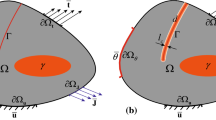Abstract
One of the main approaches for modeling fracture and crack propagation in solid materials is adaptive insertion of cohesive elements, in which line-like (2D) or surface-like (3D) elements are inserted into the finite element mesh to model the nucleation and propagation of failure surfaces. In this approach, however, cracks are forced to propagate along element boundaries, following paths that in general require more energy per unit crack extension (greater driving forces) than those followed in the original continuum. This, in turn, leads to erroneous solutions. We illustrate how the introduction of a discretization produces mesh-induced anisotropy and mesh-induced toughness for problems involving brittle fracture. Subsequently, we quantify those effects through polar plots of the path deviation ratio for commonly adopted meshes. Finally, we propose to reduce those effects through a new type of mesh, which we term conjugate-directions mesh.













Similar content being viewed by others
References
Barenblatt GI (1962) The mathematical theory of equilibrium cracks in brittle fracture. Adv Appl Mech 7:55–129
Camacho GT, Ortiz M (1996) Computational modelling of impact damage in brittle materials. Int J Solids Struct 33:2899–2938
Dijkstra EW (1959) A note on two problems in connexion with graphs. Numer Math 1(1):269–271
Du Q, Faber V, Gunzburger M (1999) Centroidal Voronoi tessellations: applications and algorithms. SIAM Rev 41:637–676
Dugdale DS (1960) Yielding of steel sheets containing slits. J Mech Phys Solids 8(2):100–104
Leon SE, Spring DW, Paulino GH (2014) Reduction in mesh bias for dynamic fracture using adaptive splitting of polygonal finite elements. Int J Numer Methods Eng 100(8):555–576
Moes N, Belytschko T (2002) Extended finite element method for cohesive crack growth. Eng Fract Mech 69:813–833
Noels L, Radovizky R (2008) An explicit discontinuous Galerkin method for non-linear solid dynamics: formulation, parallel implementation and scalability properties. Int J Numer Methods Eng 74:1393–1420
Ortiz M, Pandolfi A (1999) Finite-deformation irreversible cohesive elements for three-dimensional crack-propagation analysis. Int J Numer Methods Eng 44(9):1267–1282
Papoulia KD, Vavasis SA, Ganguly P (2006) Spatial convergence of crack nucleation using a cohesive finite-element model on a pinwheel-based mesh. Int J Numer Methods Eng 67:1–16
Paulino GH, Park K, Celes W, Espinha R (2010) Adaptive dynamic cohesive fracture simulation using nodal perturbation and edge-swap operators. Int J Numer Methods Eng 84(11):1303–1343
Radin C, Sadun L (1996) The isoperimetric problem for pinwheel tilings. Commun Math Phys 177(1):255–263
Radovizky R, Seagraves A, Tupek MR, Noels L (2011) A scalable 3D fracture and fragmentation algorithm based on a hybrid, discontinuous galerkin, cohesive element method. Comput Methods Appl Mech Eng 200:326–344
Rice JR (1968) Mathematical analysis in the mechanics of fracture. Fract Adv Treatise 2:191–311
Rimoli JJ, Ortiz M (2011) A duality-based method for generating geometric representations of polycrystals. Int J Numer Methods Eng 86(9):1069–1081
Seagraves A, Radovitzky R (2009) Advances in cohesive zone modeling of dynamic fracture. Springer, Berlin
Spring DW, Leon SE, Paulino GH (2014) Unstructured polygonal meshes with adaptive refinement for the numerical simulation of dynamic cohesive fracture. Int J Fract 189:33–57
Sukumar N, Moes N, Moran B, Belytschko T (2000) Extended finite element method for three-dimensional crack modeling. Int J Numer Methods Eng 48:1549–1570
Xu XP, Needleman A (1994) Numerical simulations of fast crack growth in brittle solids. J Mech Phys Solids 42:1397–1397
Xu XP, Needleman A (1995) Numerical simulations of dynamic crack growth along an interface. Int J Fract 74:289–324
Acknowledgments
The authors would like to acknowledge partial funding from Sandia National Laboratories under PO 1188989. Sandia National Laboratories is a multi-program laboratory managed and operated by Sandia Corporation, a wholly owned subsidiary of Lockheed Martin Corporation, for the U.S. Department of Energys National Nuclear Security Administration under contract DE-AC04-94AL85000. The authors would like to thank Dr. Alejandro Mota, Dr. James W. Foulk III, and Dr. Jakob Ostien from Sandia National Laboratories for their valuable discussions.
Author information
Authors and Affiliations
Corresponding author
Rights and permissions
About this article
Cite this article
Rimoli, J.J., Rojas, J.J. Meshing strategies for the alleviation of mesh-induced effects in cohesive element models. Int J Fract 193, 29–42 (2015). https://doi.org/10.1007/s10704-015-0013-6
Received:
Accepted:
Published:
Issue Date:
DOI: https://doi.org/10.1007/s10704-015-0013-6




